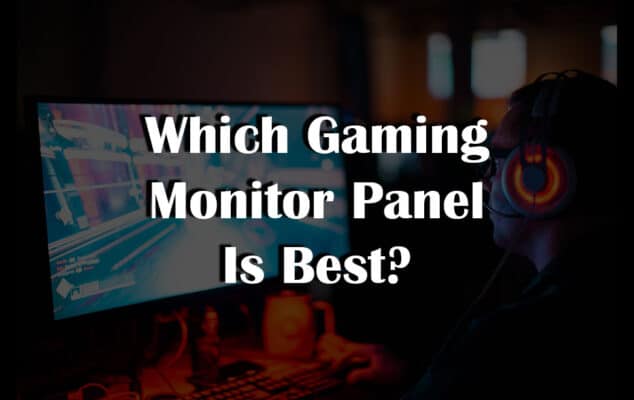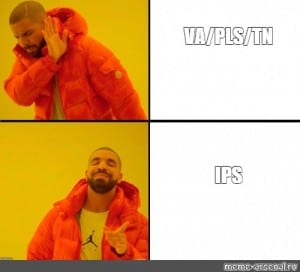You may be wondering the answer to the question of which gaming monitor panel is best. If you’re a gamer, then you know that having the right gaming monitor is essential for getting the most out of your games. But with all of the different panel types on the market, it can be hard to decide which one to choose. In this blog post, we’ll help you decide which panel type is best for you.
When it comes to gaming, the experience is only as good as the tools you use. A high-quality monitor is essential for getting the most out of your games, and there are a few different panel types to choose from. So, which one is best for gamers? Let’s take a look.
So, Which gaming monitor panel is best?
The IPS panel is the best gaming monitor for the overall gaming experience. IPS panels offer the best color accuracy and viewing angles; TN screens provide great prices. VA has excellent contrast but can be slower than other options due to their response time which balances visuals with performance.
When you’re looking for a new monitor, it’s important that the panel type suits your needs. There are multiple factors involved in choosing this big purchase and they all depend on what exactly will carry out its function with precision: from price range-to color accuracy or response time speed.
This guide will help you decide which type of monitor is best for your needs. There are three main panel types, each with its own pros and cons that should be considered when making a purchase decision.
1. IPS vs VA vs TN
You are looking for a new gaming monitor and have already decided on the essentials. You know that screen size, resolution, as well as price range, are important to you but just when things seem OK in your mind they don’t always work out like we hope they will so do research before making any purchases. There can be significant differences between panels types such as TN, VA & IPS?
When it comes to choosing the right monitor panel for your needs, there are a few key factors that you need to have in mind. Major factors such as response time, color production, contrast ratio, viewing angle, gaming style, and pricing.
| Factors | TN | VA | IPS |
| Response time | 1ms | 4-5ms | 1-8ms |
| Color reproduction | Poor | Good | Best |
| Contrast ratio | Good 1000:1 | Best 3000:1 | Good 1000:1 |
| Viewing angle | 170/160 | 178/178 | 178/178 |
| Gaming Style | Competitive FPS, MOBAs | Mix gaming | High-end graphics, local multiplayer |
| Pricing | Cheap | Average cost | Expensive |
With this knowledge, you should feel better about choosing a display that best suits your needs. The three technologies refer to how the transistors controlling pixels are produced and arranged on any panel; they all have different pros but also some cons so pay attention and not get caught up in which one is “better” without understanding what’s important for you.
TN panel type
TN panels are the oldest variety of LCD screens, but they still remain common even today. These displays have low input lag and support refresh rates up to 240Hz making them appealing for gamers in quick-paced environments who want their games played smoothly without any delays.
VA panel type
VA panels use vertically aligned liquid crystals that are perpendicular to the substrates. A substrate is another way to reference this piece of polarized glass, and when voltage is applied it tilts allowing light through its surface creating an LCD screen.
Also Read: What Refresh Rate Is Good For A Gaming Monitor? 8 Best Factors To Consider
IPS panel type
The best thing about these monitors is the rich colors they produce. They overcome the limitations of TN panels by utilizing liquid crystals aligned in parallel with each other, which allows for more detailed images and brighter displays thanks to less backlight needed per pixel compared its older counterparts like CRT or LCD screens.
Installing an IPS panel can lead to a significant increase in power consumption. This is because they have better visual quality than LED monitors, which means that there will be more demand for your computer’s resources.
2. Response time
There are a few factors that can affect your gaming experience, one of which is response time. The faster an image appears on screen and gets to all components within milliseconds will result in less input lag for players who care about competitive gameplay.
TN panels are well-known for their low response speed. A typical screen has a 1-millisecond refresh rate, and this means that there’s never any blur or ghosting when playing games on one of these types of screens.
With a VA panel, the response time is usually about 5 milliseconds. Response time is an important factor in gaming, and older IPS panels typically clocked at around 1-8ms compared to the usual TN monitor speed of about 1ms.
When it comes to playing games, a difference of 1ms vs 5 ms is not very noticeable. However the latter will give you that extra edge in fast-paced genres like first-person shooters where speed matters most. LCD screens have response times under 10ms, which means they’re better for displaying images as well as removing motion.
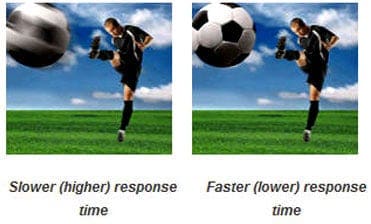
You need a gaming monitor that can handle the fast-paced action of today’s titles. Make sure you’re getting one with response time and refresh rate appropriate for each game style, but also take into consideration how quickly an image should appear on screen, do some research first.
| Factor | Response time | Refresh rate |
| Range | 5 milliseconds or below | 75 Hz or above |
| Scale | Lower is better | Higher is better |
| Sweet spot | 1 ms | 144 Hz |
Also Read: What Is The Best Response Time For A Gaming Monitor? 7 Best Ways To Find Out
3. Contrast ratio
TN panels have the lowest contrast ratios when calibrated, with an entry-level panel sitting between 700:1 and 900:1. Good quality screens push up to that 1000:1 mark. When it comes to contrast ratio, the VA panel has an edge over LCD. They offer a deep range from 3000:1 up through 6000:1 with no discernible difference in quality as you go along this spectrum.
IPS panels offer a contrast ratio of 1000:1. When you watch an environment with dark colors in your IPS panel, the blacks will be slightly greyed out to give it more depth and feel like there’s nothing between them and just vanish into suspenseful obscurity.
4. Color reproduction
When it comes to color production, the TN panel isn’t 100% accurate. The color accuracy on a VA monitor is generally good. IPS monitors offer a major benefit over other options on the market: They can produce 8-bit color (256 shades) naturally, without blending 6 bits per pixel for the same effect as TN screens generally do.
Also Read: Do You Need A Good Monitor For Gaming? 9 Best Factors To Consider
5. Viewing angles
The biggest downside to TN panels is their narrow viewing angles, which go down as low as 170/160 degrees. Looking from a wide perspective will show considerable color shift and slight image fading over time due in part to Electromagnetic Distortion (EMD).
With a VA panel, you can expect to see colors that exceed the standard RGB gamut and often reach Adobe’s much richer color range. These wide viewing angles make for an amazing experience no matter where on your screen they appear.
IPS panels offer a wide 178/178 viewing angle which means clear views from almost any direction. It is the best experience for shared viewing and will serve you well if there are people over who want to look at your screen together without having their own monitor or television set available as well.
The best viewing position is one that allows you to keep your head still and lowers the risk for neck or eye strain. A 15-degree downward angle is key, as it reduces these problems by preventing involuntary movements caused from looking up too far; maintaining this position will also increase comfort levels significantly.
There are many types of monitors available in the market today, but not all have great viewing angles. For instance, IPS panels offer a wider angle for your screen compared to TN or VA panel type displays which can be limiting if you want more than two people watching simultaneously from different positions near each other when playing multiplayer games.
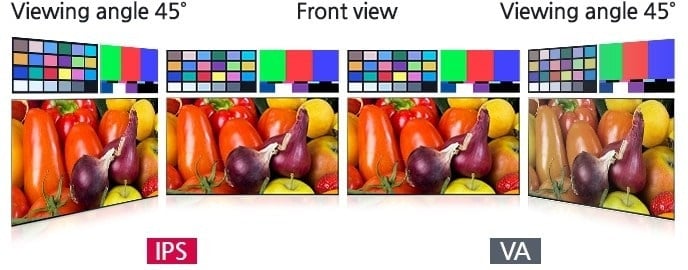
The perfect viewing angle for gaming is about 15 degrees, but if you want to get the most out of your experience and avoid eye fatigue then we recommend at least 20-degree setups.
What are the Best Viewing Angles for Gaming Console?
The console’s optimal viewing angle is 30 degrees, but it can be viewed at other angles as well. TVs with wider curves provide a better experience for players and so do those that have darker backgrounds because they make games seem more immersive.
The panel type you choose can affect your other aspects along with response rate and may not bring the factors such as viewing angles or color reproduction. Competitive gamers are known for preferring TN panels because they provide faster speeds, but this comes at a sacrifice in terms of VA & IPS display technologies that offer better quality images overall.
6. Gaming style
If you’re looking for a panel that provides both good visuals and performance, then an IPS or VA will be best. TN screens have lower prices but tend to lack contrast; this means they don’t show off colors as vibrantly on average.
Casual Gaming
The VA panels have the highest contrast ratio, but it usually comes at a cost of slower response time. They’re excellent for watching movies and racing games because they don’t sacrifice performance when there’s no action going on screen; however competitive gamers should look elsewhere as these types suffer from motion blur easily due to their inability to generate rapid updates in frames per second (FPS).
Competitive Gaming
With a faster response time and better picture quality, competitive esports gamers will choose to use TN panels for their gaming needs. TN monitors are the way to go if you’re looking for fast displays with low image quality. They have lower refresh rates and slower response times than IPS panels but offer guaranteed high frame rates in games.
Also Read: What is the Difference between Gaming Monitor and Regular Monitor? 7 Best Factors To Consider
7. Pricing
TN panel comes at a cheaper price. VA panels average cost, and IPS ones are higher in price tag. The cost of a TN VA IPS panel is determined by its resolution and type. A higher-resolution panel will generally be more expensive than one with lower pixel counts because it requires greater amounts from both the hardware side as well as software development time in order to produce an image that meets industry standards.
Which type of monitor panel is best?
IPS monitors provide the best experience for shared viewing, so if you have people over and they’re all looking at different screens from their own angles an IPS will serve them well. Response times have improved notably on these types of panels in recent years; now it’s possible to match VA speed but still lag behind TN panel types.
Also Read: What Is The Best Monitor Size For Gaming? 3 Significant Factors
Is VA or IPS better?
IPS panels offer a wide viewing angle and low contrast ratio, while VA panels tend to have higher quality images with rich colors but reduced brightness. It’s important to consider the viewing angle of a display when buying one. A VA panel provides a superior contrast ratio but narrows down your field of view while an IPS panel has wide angles and low pixel density which makes them less useful in places with strong lighting.
Is TN or VA better?
TN panels are the fastest and cheapest among all other main types of display screens. VA panels have better contrast and offer a good balance between visuals, but their response times tend to be higher.
Also Read: TV vs Monitor For Gaming? 10 Ways To Choose The Best
Is TN or IPS better?
The difference in image quality between an IPS panel and a TN one is so significant that it’s worth spending more money on. Not only do IPS panels offer better colors, but you’ll be able to see everything clearly without any blurriness or distortion when playing games on TN panels.
Best Gaming Monitors
The best gaming monitors on today’s market can withstand a lot of stress. If you plan to play your video games with all bells and whistles turned up, then these are the models for you. We’ve added our recommendations along with pros and cons for each of the 15 gaming monitors that will give you some idea about them.
| Name | Panel Type | Screen Type | Refresh Rate | Response Time | Adaptive Sync | Our Recommendation |
| Samsung Odyssey G7 | VA | Widescreen Curved | 240Hz | 1ms | G-Sync | Read More |
| Alienware 25 | TN | Standard Widescreen | 240Hz | 1ms | G-Sync | Read More |
| ViewSonic Elite XG270 | IPS | Standard Widescreen | 240Hz | 1ms | G-Sync | Read More |
| Acer Nitro VG271U | IPS | Standard Widescreen | 240Hz | 1ms | G-Sync | Read More |
| Sceptre C305B-200UN | VA | Ultrawide Curved | 200Hz | 5ms | FreeSync | Read More |
Also Read: How To Choose A Gaming Monitor? 11 Best Factors To Consider
Best Budget Gaming Monitors
The following are the top 5 best gaming monitors based on our experiences. All of them have very fast response times and adaptive sync features that work well with most computers, making them perfect for gamers. They also come at below $450 which means you can find something affordable too.
| Name | Panel Type | Screen Type | Refresh Rate | Response Time | Adaptive Sync | Our Recommendation |
| MSI Optix G24C | VA | Standard Widescreen | 144Hz | 1ms | FreeSync | Read More |
| Sceptre C305B-200UN | VA | Ultrawide Curved | 200Hz | 5ms | FreeSync | Read More |
| Aorus G27FC | VA | Widescreen Curved | 165Hz | 1ms | FreeSync | Read More |
| Acer Nitro VG271U | IPS | Standard Widescreen | 240Hz | 1ms | G-Sync | Read More |
| ViewSonic Elite XG270 | IPS | Standard Widescreen | 240Hz | 1ms | G-Sync | Read More |
It can be hard to decide which gaming monitor panel is best for you. Do you want the best color reproduction? The fastest response time? The widest viewing angles? We’ve tried to make your decision a little bit easier by outlining the pros and cons of each type of gaming monitor panel.
But, in the end, only you can decide which one is best for your needs. Let us know in the comments which type of gaming monitor you prefer and why. We would love to hear from you.
